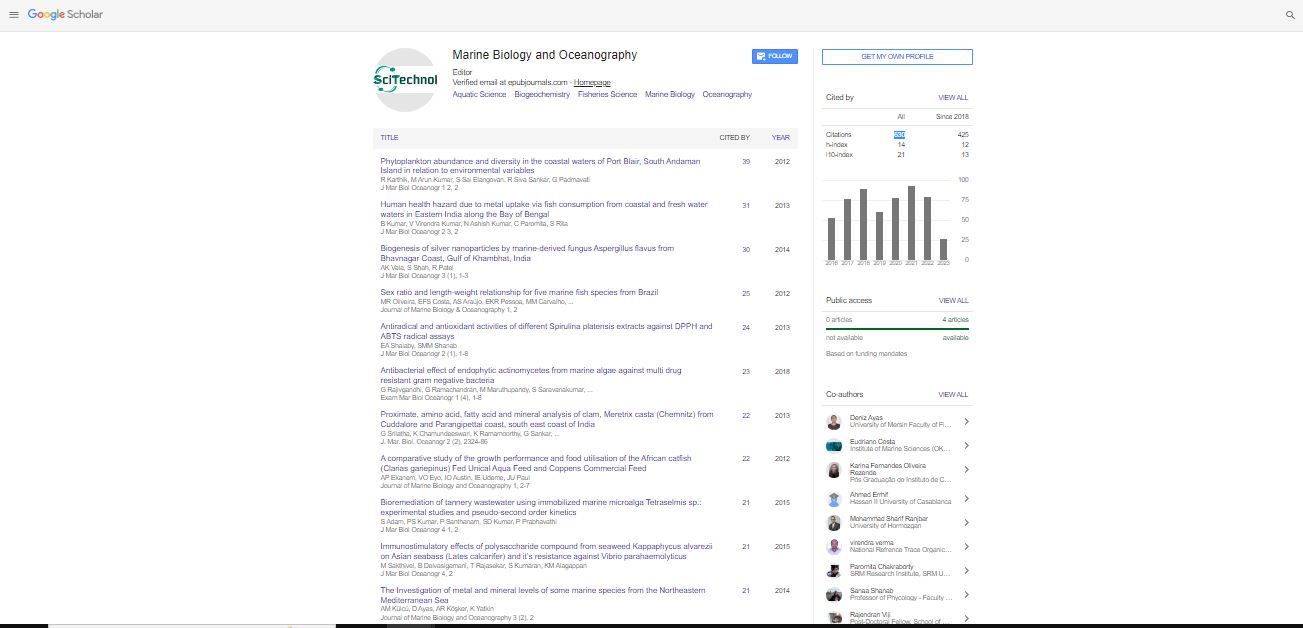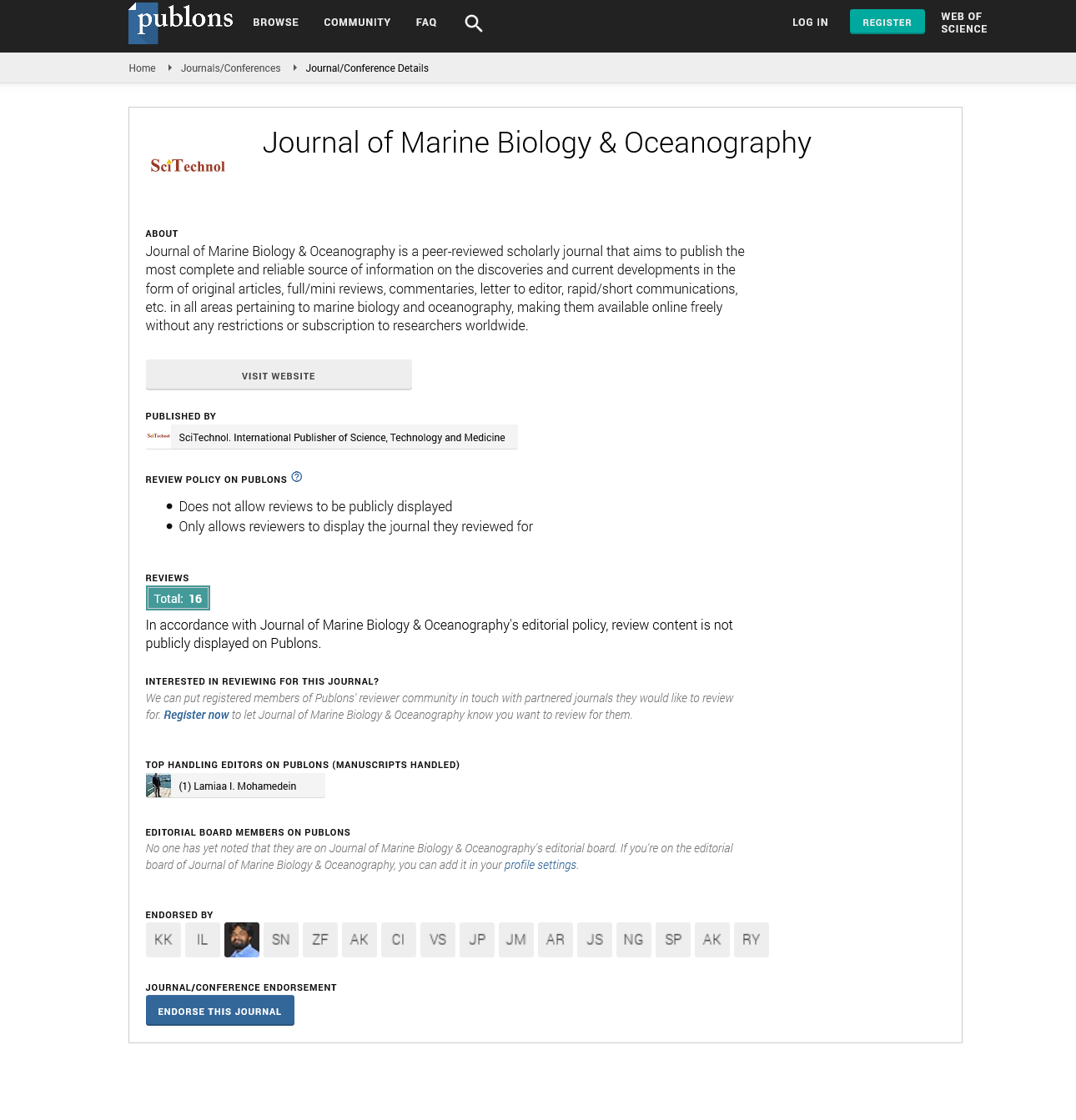Perspective, J Mar Biol Oceanogr Vol: 11 Issue: 4
Effort Regulates Positive of Take Marine Protected Areas
Ni Tsai*
Department of Life Sciences and Innovation and Development Center of Sustainable Agriculture, National Chung Hsing University, Taichung, Taiwan
*Corresponding author: Ni Tsai
Department of Life Sciences and Innovation and Development Center of Sustainable Agriculture, National Chung Hsing University, Taichung, Taiwan
Email: nitsai345@gmail.com
Received date: 21 March, 2022, Manuscript No. JMBO-22-62318;
Editor assigned date: 23 March, 2022, Pre QC No. JMBO-22-62318 (PQ);
Reviewed date: 03 April, 2022, QC No JMBO-22-62318;
Revised date: 13 April, 2022, Manuscript No. JMBO-22-62318 (R);
Published date: 22 April, 2022, DOI:10.4172/2324-8661.1000239
Citation: Tsai N (2022) Effort Regulates Positive of Take Marine Protected Areas. J Mar Biol Oceanogr 11: 4.
Keywords: Marine Protected Areas
Introduction
There's a frequent energy inflow connection between aqueducts and riparian zones. Still, riparian communities have been limited in studies of sluice ecosystems. To understand the significance of riparian communities in the energy inflow of sluice ecosystems, we compared two trophic models in a small timber influent and the mainstream that held high and low biomasses of riparian foliage and arthropods, independently. There were functional groups classified into integer trophic situations in the two trophic models. Arthropods, substantially insects, were the main carrier of the energy inflow between submarine and riparian territories. The feeding connections were more expansive and ferocious in the influent than in the mainstream, as riparian arthropods were more abundant in the influent. When including the riparian community in the influent, the trophic model came more mature, as the values of system omnivore indicator and trophic transfer effectiveness and the ascendance capacity rate were advanced, but the connect indicator value and outflow capacity rate were lower in the model with riparian groups than in the model without riparian groups. In the influent, the Eco trophic Effectiveness (EE) values of submarine nonentity groups increased largely if the riparian community was included in the model. In the mainstream, still, utmost of the ecosystem attributes and the EE values of submarine nonentity groups didn't obviously change if the model included the riparian community. This study highlights the significance of riparian communities in the energy inflow of tropical sluice ecosystems. Submarine and riparian systems should be considered together as a mature ecosystem for the planning of sluice conservation. The loss or declination of one niche may have further mischievous goods on the other community than we've preliminarily honored, particularly in a small timber sluice. The geochemistry of rare earth rudiments (REEs) in riverine Suspended Peck Matter (SPM) is an important part in indicating gemstone riding processes. Still, it has been unclear whether budgets can beget variations of geochemical characteristics and actions of REEs in SPM. In the present study, the REE contents and fractionations in SPM were delved passing through waterfall budgets in the Lancangjiang River. Large-sized budgets affected riverine temperature, pH, and dissolved oxygen, but didn't affect electric conductance, total dissolved solids, and HCO3−attention. Budgets affected the compositions of major rudiments in SPM by the division of different minerals passing through heads.
Also increased continuously after passing through heads. The variations of REE contents in SPM passing through heads are nearly linked to the division of complexion minerals because complexion minerals deduced from feldspar riding are the main carriers of REEs in SPM. The stress-grade thesis predicts that biotic relations within food webs are environment dependent, since environmental stressors can devaluate consumer–prey relations. Though the translocation of chromosomes occurs spontaneously, there are also threat factors that could contribute to arise. These threat factors include radiation exposure, age, gender, race etc. People who have been exposed to high- cure radiation have an advanced threat of suffering from CML, since radiation can damage the cell and causes mutation. For illustration, survivors from the 1986 Chernobyl nuclear reactor disaster were plant to have an advanced threat of getting leukemia, aftertwo to five times of the incident. Age is also another crucial threat factor in regard to CML. CML is uncommon in children or teens since its threat increases as age goes up. Utmost people that are diagnosed with CML are in the average age of around. CML is also plant to be more common amongst males than ladies; still, the reason of this observation is still unknown. Non-Hispanic whites are plant to be the most common in getting CML, followed by blacks, while the smallest chance is plant in Asian and Pacific Islanders. Yet, how heavy essence pollution influences the impacts of raptorial fish on ecosystem structure is unknown. This study was conducted in the Osor sluice (Spain), which features an essence (substantially Zn) pollution grade. We aimed to determine how the responses of oceanographic communities to the presence and absence of raptorial fish interact with environmental stress and to test whether the top-down control of top bloodsuckers is environment dependent. To address these questions, periphyton biomass and macro invertebrate consistence were determined throughout an exclosure/quadrangle microcosm trial using the Mediterranean barbel (Barbus meridionalis) as a top bloodsucker. The monitoring study showed that essence accumulation in periphyton and macro invertebrates reflected patterns observed in water. The microcosm study showed that fish predation goods on larval chironomids weren't environment-dependent and that periphyton biomass was markedly lower in the presence of fish anyhow of essence pollution situations. This strong top-down control on periphytic algae was attributed to the rustling geste of fish causing bioturbation. In discrepancy, the top bloodsucker junking revealed scrape-periphyton relations, which were intermediated by heavy essence pollution. That is, periphyton advantaged from a lower grazing pressure in the essence- defiled spots. Together, our results suggest that the top–down control by fishes depends more on functional traits (e.g. feeding geste) than on feeding council, and demonstrate the capacity of top bloodsuckers to modify anthropogenic stressor goods on sluice food- web structure. The Matusagaratí Wetland in the Panamanian Darien develops in fluvial surroundings associated with the Tuira River. The end of this exploration is to determine the origin and dynamics of the water flows that sustain the Matusagaratí Wetland, studying the overflows of face water and groundwater, as well as the benefactions deduced from rush. Understanding the benefactions and overflows of water within the swamp acquires both hydrological and ecological significance, since deluge events contribute to the accumulation of sediments and the transport and disbandment of seeds and fish naiads, playing an important part in the swamp ecosystems and foliage variability.
 Spanish
Spanish  Chinese
Chinese  Russian
Russian  German
German  French
French  Japanese
Japanese  Portuguese
Portuguese  Hindi
Hindi 
